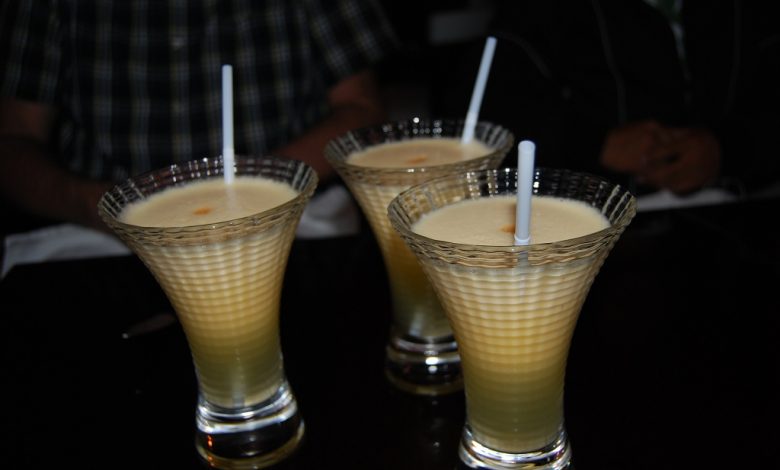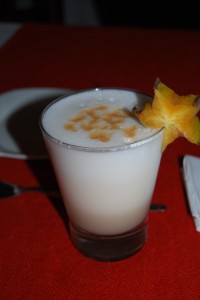Cheers, Pisco and Peru

This week Peru celebrates its anniversary in an outpouring of national pride. While patriotism is part of the air people breathe as they grow up in a country that every Sunday celebrates the “Raising of the Flag” in plazas around the county, it is also increasingly a matter of marketing.
Peru settled earlier this year on a national trademark and is increasingly seeing its cuisine as a kind of culture to be actively promoted, both nationally and internationally. One of its key elements for promotion is pisco, Peru’s signature beverage, distilled from fermented grapes.
Pisco has a strong presence in Cuzco. Pisco Sours, the drink concocted along the lines of a Whisky Sour, according to Maria Benavides, is widely offered to tourists as an enticement by barkers along the main streets of the colonial area. Furthermore, excellent bars specializing in fine pisco and drinks made from it have opened in the city. These include El Pisquerito, in the Casa Qoriqente development on San Juan de Dios Street, as well as restaurants such as Limo and more recently Yuraq.
Sometimes compared with brandy, also distilled from grapes, pisco has a long history in Peru. Shortly after their invasion the Spaniards began growing grapes and producing wines following traditions in their homelands. The region near the contemporary city of Pisco proved particularly suited to grapes and the production of beverages from them.
Given its importance in colonial times, when the Viceroyality of Lima governed all of Spanish South America, the distilled grape juice from Pisco became justifiably famous and its name, in a difficulty that many trademarks have faced, became a more general term for distilled wine, in part because of the pottery jars which were called pisqos and which carried the beverage on mule back throughout the Andes.

In recent times this became a stumbling block for Peru and for Peruvian Pisco. Chile, relying on difference groups, also made a brandy-like beverage called pisco. Bolivia did as well. But Bolivia named its distillation “singani” while the Chileans insisted on calling their’s Pisco. The Chileans furthermore systematized the production of the drink and made it a much more consistent product, while the Peruvian was the product of many distilleries, medium or small in the Pisco valley.
Chile then sought international recognition for the trademark “Pisco” which led to a conflict with Peru. Chile both argues that the word “pisco” is a specific brand of beverage produced in Chile with legal protection at the same time it is a generic word for distilled wine.
In contrast, Peru argues that pisco, like champagne, should be seen as a beverage produced in a certain terroir, landscape–the valley of pisco. It initiated a process to seek international protection of its rights and the rights of its producers to the name “pisco” and its separation from the claims of Chileans and their rather different product.
In colonial times the economy of food production was quite different than it is today. In modern times, brands and trademarks claim market rights and demand consumer loyalty. They also become the terrain of national pride and identity. Food writer Mariella Balbi, for example, entitled her book on the history of pisco with the gradiloquent title Pisco es Peru.
And, as a symbol of the country, its pride and its claims, at the same time it is a privately produced product, pisco is Peru, especially as Peruvian independence day nears.

Of course pisco is not the only symbol which Peru contests with its neighbors. Recently, a mask and costume representing a dance of devils became a matter of international dispute between Peru and its neighbor Bolivia. The Bolivians are attempting to trademark the dance as Bolivia while Miss Peru wore it in the Miss World beauty pageant, leading to international outcry and diplomatic effort.
As culture increasingly becomes a commodity, more such conflicts will arise. History and nation, do not so easily fit together with clean boundaries. Nevertheless, there is no doubt that pisco is an outstanding beverage.
Johnny Schuler, the head of the National Tasters Guild has been tasked with tasting liquors which sought the official appellation of “pisco” and defines a good pisco as a balance between the sharpness of the alcohol and the more fruity flavors from the grapes.

He says that a good pisco “should be colorless and transparent. It should have a clean and crystaline appearance. In sum it should shine. Then we should smell it; it should have a light odor of grapes and ripe fruit, the alcohol should not burn.”
A good pisco is a delight. As one lifts a shot of pisco or one of the many concoctions made from it to salute Peru on its day, one not only raises a fine beverage and symbol of the country, one also lifts some of the complex history and conflict that has made the country Peru.




